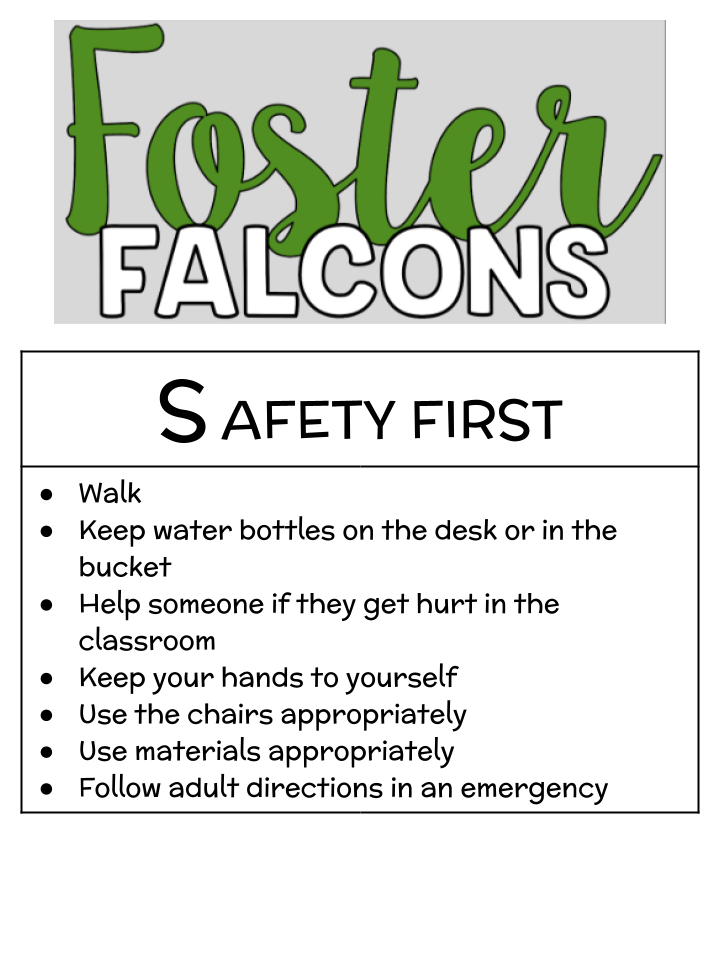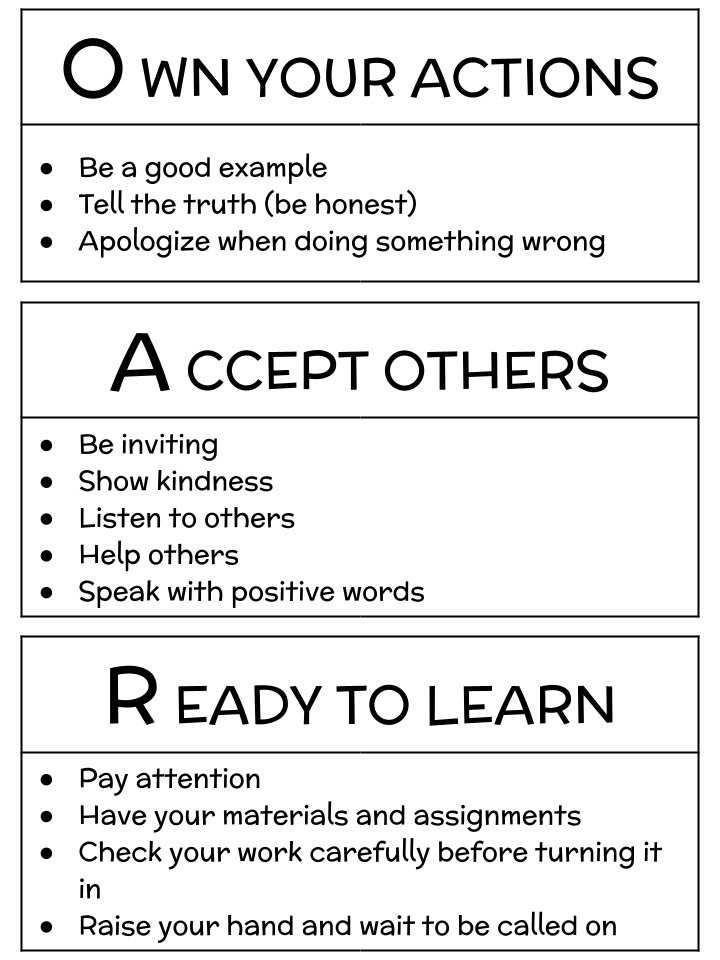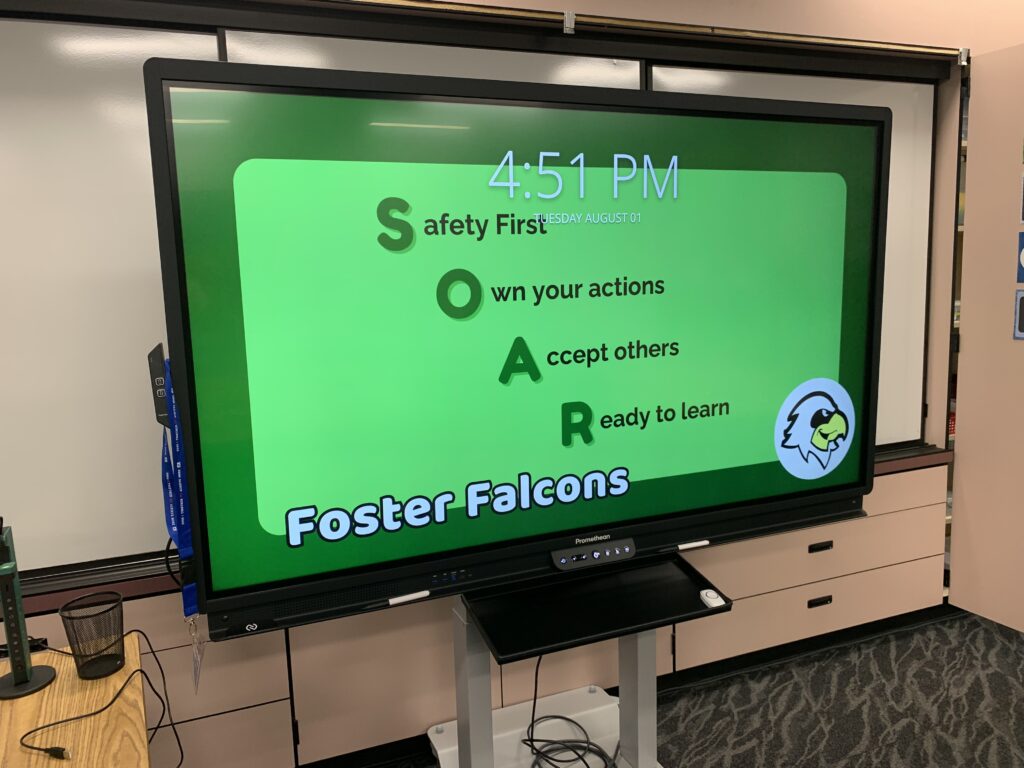
I don’t know about you, but it is taking me longer to get my students’ behavior under control. Five years ago my class would be a well-oiled machine with minimal distractions by Thanksgiving. Now, it seems like we’re constantly moving at a turtle pace to reach the goal of appropriate classroom behavior. Thankfully there are steps you can take to help your students thrive behaviorally in your classroom, while also keeping your sanity.
1. Establish Clear Behavior Expectations:
Clearly communicate your expectations for behavior from the beginning of the school year or semester. Continually reteach these expectations throughout the year. Establishing a set of rules and consequences helps students understand the boundaries and the consequences of their actions. Make sure to be consistent in enforcing these expectations.
How I Establish Behavior Expectations in My Classroom
In my classroom, we took our schoolwide PBIS expectations (Safety First, Own Your Actions, Accept Others, Ready to Learn) and developed our specific classroom expectations within those four areas. I worked as a facilitator to guide the students in the appropriate direction. This list is now printed, laminated, and hung in the front of our classroom for all to see. It is a visual reminder of the expectations and is referenced frequently throughout the week. I also created a desktop image for our Promethean interactive display that reminds all students of our schoolwide behavior expectations.



If you are an online teacher, you can easily establish clear behavior expectations too! During COVID I used a digital set of online classroom expectations posters. These posters were reviewed often.
2. Build Positive Relationships:
Foster positive relationships with your students. Take the time to get to know them individually, showing genuine interest in their lives and well-being. When students feel a connection with their teacher, they are more likely to cooperate and respond positively to guidance.
How I Build Positive Relationships in My Classroom
I can’t emphasize this enough. Get to know your students! This year I have some challenging behaviors, but I’m starting to see change in some of my special friends. Since I’m able to connect with them on a personal level, they are more willing to listen to me when I redirect their inappropriate behavior. They’re learning to trust that I have their best interest at heart.
One of the ways I’m learning more about them is through research projects using Google Slides. My students love creating Google Slides presentations when they have finished their assigned work. Through these creations, I’ve found out that M is obsessed with the Titanic, E is a huge basketball fan, and D is a budding fiction writer. Giving my students some freedom, within established boundaries, has not only helped them deepen their academic skills, but it has also allowed me to learn more about them.
3. Use Positive Reinforcement:
Acknowledge and reinforce positive behavior. Positive reinforcement, such as praise, rewards, and recognition, can be powerful motivators for students. When students receive positive attention for their good behavior, they are more likely to repeat those actions.
How I Use Positive Reinforcement in My Classroom
I use individual and classwide positive reinforcements. Students will individually receive verbal praise/recognition when they demonstrate the expected behavior. I also use our school’s PBIS reward system of SOAR tickets. These tickets can then be turned in for various prizes.
As a class, the students earn marbles for showing whole class appropriate behavior. To add buy-in, I use my grandfather’s marbles from when he was a boy. There is something about telling the students that the marbles are over 70 years old that makes it more exciting for them. Once the students get all of the marbles in their class jar we have a Marble Party. This party can range anywhere from watching a movie, to playing at the local park, to a special dress-up day, and so much more. As a class, they vote on their favorite choice and we take the time to celebrate their behavior achievement.
4. Implement Consistent Consequences:
Consistency is key when dealing with difficult behavior. Clearly outline the consequences for inappropriate actions and consistently apply them. This consistency helps students understand the link between their behavior and the resulting consequences. It also helps to promote accountability.
How I Implement Consistent Consequences in My Classroom
I learned long ago that clip charts and names on the board were not effective consequences for student behavior. I couldn’t implement them consistently and I didn’t see the behavior change that was needed. Now I follow these four easy steps:
1. Verbal Warning –
The verbal warning is very specific with what behavior is expected to stop. If a student is continually talking to their neighbor instead of completing their work I don’t use the phrase “stop doing that.” Instead, I tell them that they need to stop talking and complete their work.
2. Behavior Think Sheet –
The behavior think sheet provides students with an opportunity to reflect on what they’ve done and what they need to do in the future. It also allows me to see what they think they’ve done wrong. Sometimes my students don’t recognize the inappropriate behavior. When this happens, I spend extra time speaking with them to help them understand what they need to fix for the future. I also use the behavior think sheet as a form of home communication. This allows parents/guardians to be part of the conversation.
3. Loss of Privilege(s) –
If the inappropriate behavior continues, then the student needs additional help to make the appropriate changes. I don’t use time away from recess/lunch as a consequence. Instead, I make some sort of change in their classroom environment. This can be as simple as turning around the desk of a student who is continually off task during instruction. It can also be moving someone’s desk to a different location. Or even limiting their technology access due to inappropriate technology behaviors.
4. Begin to Provide Tier II/III Behavior Supports –
If a student is consistently getting past step 3, then they need more help than a typical student. In my classroom, this involves using daily behavior reports for consistent parent communication or specific behavior goals. I also make sure I speak with my administrator and/or school social worker so they know what I’m doing and see if they have any additional suggestions. As my school’s Tier II PBIS coach, I am constantly looking at how we can support our students who don’t fit the typical mold.
5. Implement Effective Classroom Management Strategies:
Use effective classroom management strategies to prevent and address challenging behavior. This may include creating a structured and engaging learning environment, using proactive techniques to minimize disruptions, and having a variety of instructional approaches to cater to diverse learning styles.
How I Implement Effective Classroom Management Strategies in My Classroom
My classroom has a very consistent routine. Every day we go over the posted schedule and talk about “the plan.” Should things change, I always try to warn my students as soon as I know about the changes. In addition, I am constantly looking for ways to engage my students in the learning process. This is as simple as a chant/song, using whiteboards instead of lined paper, and constant movement. It becomes a bit more challenging when I incorporate ed tech options such as Flipgrid, Wakelet, Common Sense Education’s Digital Citizenship curriculum, and computer science options. However, the more structured and engaging I am, the more likely I am to have fewer behaviors.
Final Thoughts:
Don’t forget … each student is unique, and it may be necessary to tailor your approach based on individual needs, however, the more structured and consistent you can be the better. Also, involving parents or guardians in the process can be incredibly helpful. Working as a team often leads to better outcomes for students with challenging behavior. Finally, when needed, ask for help. Even as an experienced teacher, I ask for help because I want the best for my students. There are others out there who can be great resources for ways to help your students. Don’t be afraid to reach out.
My students have come a long way with their behavior. When I focus in with a tight lens I easily become discouraged, but when I look at the boarder picture I can see the growth we’ve accomplished over the year. Don’t be discouraged if your students’ behavior doesn’t change quickly. Keep using the steps and focus on the broader picture.
Related Articles:
